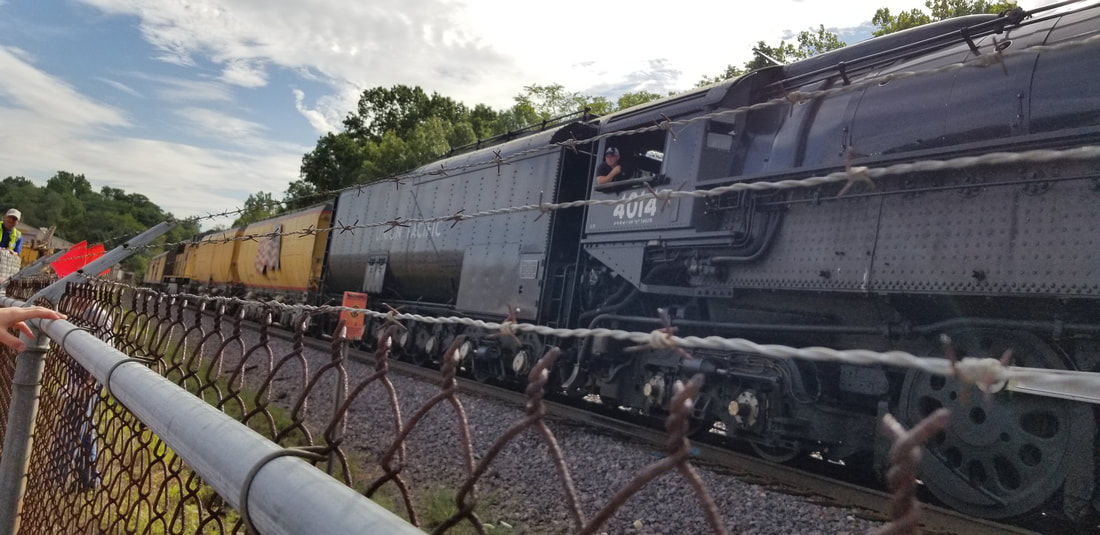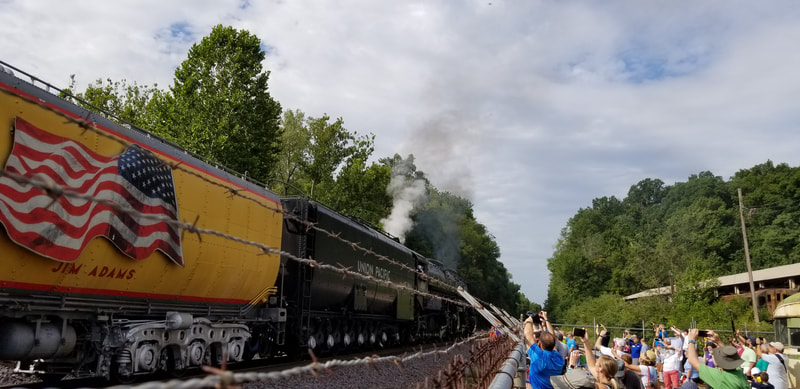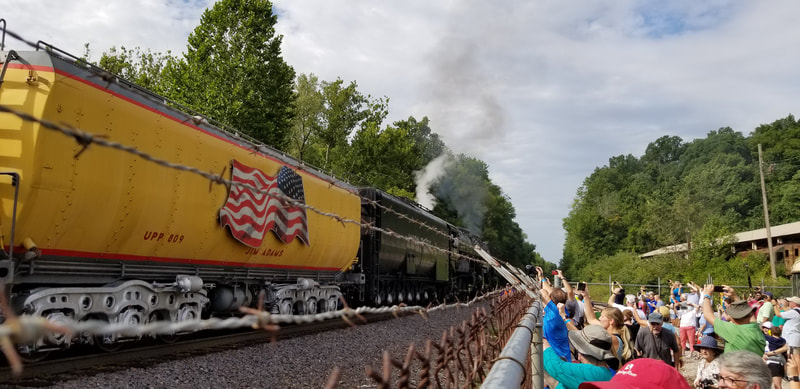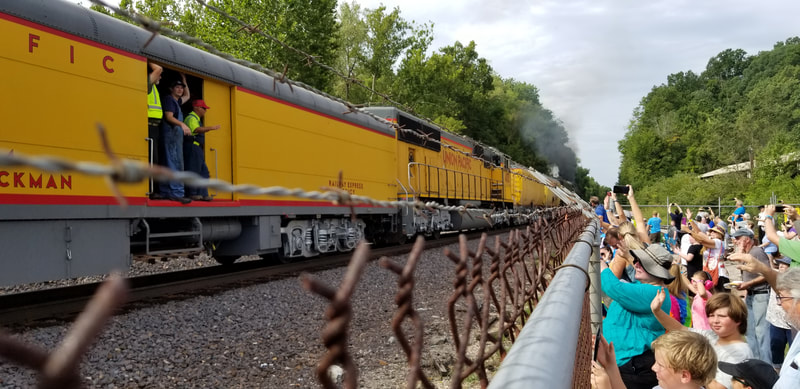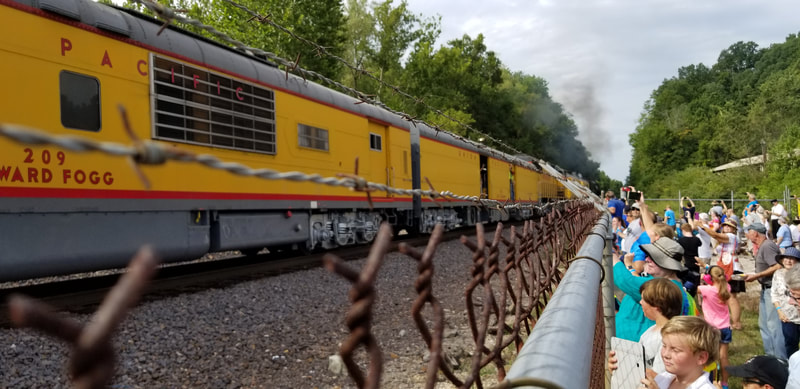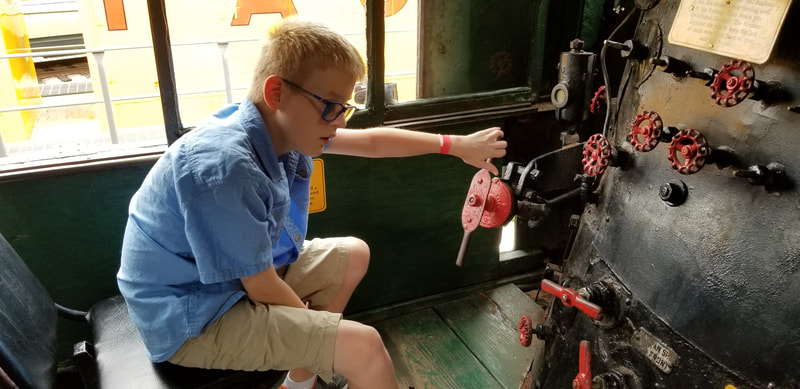Big Boy
Rich and Carol had the opportunity to view the only working Big Boy steam locomotive on Monday, August 30, 2021, at the Museum of Transportation in St. Louis.
Twenty-five Big Boys were built exclusively for Union Pacific Railroad, the first of which was delivered in 1941. The locomotives were 132 feet long and weighed 1.2 million pounds. Because of their great length, the frames of the Big Boys were "hinged," or articulated, to allow them to negotiate curves. They had a 4-8-8-4 wheel arrangement, which meant they had four wheels on the leading set of "pilot" wheels which guided the engine, eight drivers, another set of eight drivers, and four wheels following which supported the rear of the locomotive. The massive engines normally operated between Ogden, Utah, and Cheyenne, Wyo.
There are seven Big Boys on public display in various cities around the country. They can be found in St. Louis, Missouri; Dallas, Texas; Omaha, Nebraska; Denver, Colorado; Scranton, Pennsylvania; Green Bay, Wisconsin; and Cheyenne, Wyoming.
Big Boy No. 4014 was delivered to Union Pacific in December 1941. The locomotive was retired in December 1961, having traveled 1,031,205 miles in its 20 years in service. Union Pacific reacquired No. 4014 from the RailGiants Museum in Pomona, California, in 2013, and relocated it back to Cheyenne to begin a multi-year restoration process. It returned to service in May 2019 to celebrate the 150th Anniversary of the Transcontinental Railroad's Completion.
The restored Big Boy No. 4014 departed Cheyenne, Wyoming, Thursday, Aug. 5, to travel through Arkansas, Colorado, Kansas, Illinois, Louisiana, Missouri, Nebraska, Oklahoma, Texas and Wyoming.
While we were at the museum we were able to see Big Boy 4006 that is on display in St. Louis.
Twenty-five Big Boys were built exclusively for Union Pacific Railroad, the first of which was delivered in 1941. The locomotives were 132 feet long and weighed 1.2 million pounds. Because of their great length, the frames of the Big Boys were "hinged," or articulated, to allow them to negotiate curves. They had a 4-8-8-4 wheel arrangement, which meant they had four wheels on the leading set of "pilot" wheels which guided the engine, eight drivers, another set of eight drivers, and four wheels following which supported the rear of the locomotive. The massive engines normally operated between Ogden, Utah, and Cheyenne, Wyo.
There are seven Big Boys on public display in various cities around the country. They can be found in St. Louis, Missouri; Dallas, Texas; Omaha, Nebraska; Denver, Colorado; Scranton, Pennsylvania; Green Bay, Wisconsin; and Cheyenne, Wyoming.
Big Boy No. 4014 was delivered to Union Pacific in December 1941. The locomotive was retired in December 1961, having traveled 1,031,205 miles in its 20 years in service. Union Pacific reacquired No. 4014 from the RailGiants Museum in Pomona, California, in 2013, and relocated it back to Cheyenne to begin a multi-year restoration process. It returned to service in May 2019 to celebrate the 150th Anniversary of the Transcontinental Railroad's Completion.
The restored Big Boy No. 4014 departed Cheyenne, Wyoming, Thursday, Aug. 5, to travel through Arkansas, Colorado, Kansas, Illinois, Louisiana, Missouri, Nebraska, Oklahoma, Texas and Wyoming.
While we were at the museum we were able to see Big Boy 4006 that is on display in St. Louis.
Big Boy 4014
Big Boy 4006
Known as a “Big Boy” because of its immense size and power, Union Pacific Railroad #4006 is one of the world’s largest successful steam locomotives.
Built in 1941 by the American Locomotive Company at a cost of $265,000.00 and with a total weight of over 600 tons, Number 4006 is one of 25 Big Boys. It is 132′ 9 1/4″ long, carries 33 tons of coal and 25,000 gallons of water in its tender. It is a 4-8-8-4 (simple) articulated locomotive.
Built in 1941 by the American Locomotive Company at a cost of $265,000.00 and with a total weight of over 600 tons, Number 4006 is one of 25 Big Boys. It is 132′ 9 1/4″ long, carries 33 tons of coal and 25,000 gallons of water in its tender. It is a 4-8-8-4 (simple) articulated locomotive.
